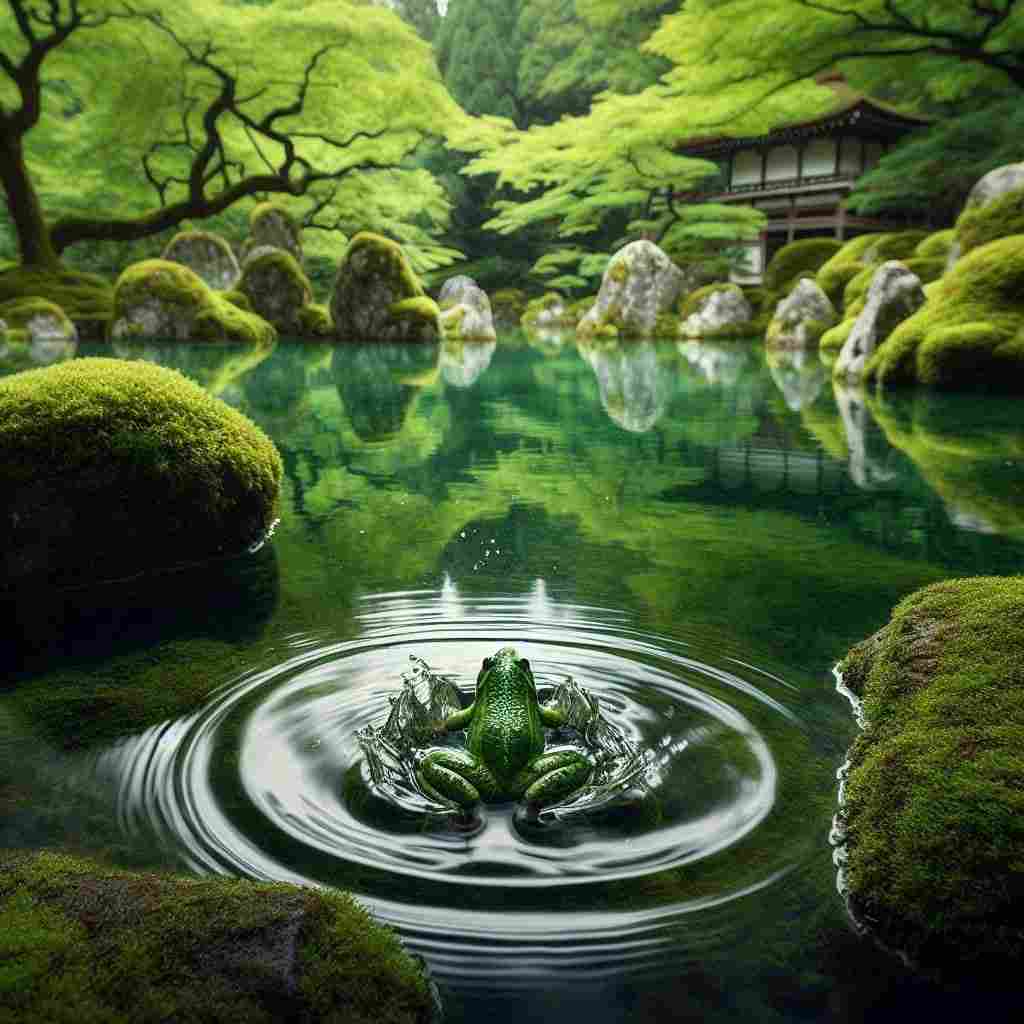Frog Haiku (Japanese)
Matsuo Bashō
1644 to 1694

Want to track your favorites? Reopen or create a unique username. No personal details are required!
古池や 蛙飛び込む 水の音
(Furu ike ya / kawazu tobikomu / mizu no oto)
Old pond / A frog leaps in / Sound of water,
Old pond sits still, memories deep
Centuries of silence it keeps
Then in a moment, life leaps in
A splash that breaks the quiet's reign
One frog, one jump
One ripple in time
Old pond, new sound
A moment sublime
Water's voice, briefly awoken
Nature's poetry unspoken
In that sound, a truth unfolds
Of change and constants, young and old
古池や 蛙飛び込む 水の音
(Furu ike ya / kawazu tobikomu / mizu no oto)
In the span of a heartbeat
Past and present meet
A simple act, profound and neat
The cycle of life complete
One frog, one jump
One ripple in time
Old pond, new sound
A moment sublime
Old pond
A frog leaps in
Sound of water
古池や 蛙飛び込む 水の音
(Furu ike ya / kawazu tobikomu / mizu no oto)
Old pond waits, for the next surprise
Where stillness and motion harmonize
Matsuo Bashō's Frog Haiku
Matsuo Bashō’s haiku, “Old pond / A frog leaps in / Sound of water,” epitomizes the essence of traditional haiku: simplicity, brevity, and profound depth. This adaptation remains rooted in the haiku’s imagery while weaving a narrative that amplifies its themes of transience, stillness, and the interplay between the eternal and the momentary. Through the use of extended metaphors, rhythmical refrains, and meditative reflections, the adaptation bridges classical Japanese poetic tradition and contemporary expression.
Thematic Expansion
-
Stillness and Motion:
-
The adaptation retains the original's juxtaposition of the stillness of the pond with the sudden motion of the frog. The lines:
"Old pond sits still, memories deep / Centuries of silence it keeps" evoke the passage of time and the constancy of the pond, emphasizing its role as a repository of history and silence. The imagery of "memories deep" anthropomorphizes the pond, suggesting that it bears witness to countless unnoticed moments.
-
This stillness is disrupted by the frog’s leap, a metaphor for life's inevitable interruptions:
"Then in a moment, life leaps in / A splash that breaks the quiet's reign."
-
-
Ephemerality and Timelessness:
- The adaptation delves into the transient nature of existence:
"One ripple in time / Old pond, new sound." The "ripple in time" signifies the fleeting moment’s impact, while "new sound" reaffirms the dynamic interplay of change and continuity. The timelessness of the old pond contrasts with the ephemerality of the frog's action, a meditation on life’s cyclical nature.
- The adaptation delves into the transient nature of existence:
-
Harmony and Surprise:
- The concluding refrain underscores the coexistence of constancy and unpredictability:
"Old pond waits, for the next surprise / Where stillness and motion harmonize." The pond is portrayed as an eternal stage, anticipating the next act in the unending performance of nature.
- The concluding refrain underscores the coexistence of constancy and unpredictability:
Form and Structure
The adaptation employs a hybrid structure that integrates haiku's minimalism with more elaborate poetic forms:
- Repetition: The refrain "Old pond / A frog leaps in / Sound of water" mirrors the original haiku’s cyclical simplicity. Its repeated appearance reinforces the meditative quality of the poem and recalls the iterative patterns of nature.
- Free Verse Expansion: The additional stanzas provide narrative depth, exploring the implications of the haiku’s imagery. Lines such as:
"In that sound, a truth unfolds / Of change and constants, young and old" reveal philosophical reflections absent from the concise original but aligned with its spirit.
- Rhyme and Rhythm: The couplets and quatrains:
"One frog, one jump / One ripple in time" lend a musicality that echoes the splash's resonance, enhancing the poem's auditory experience.
Imagery and Symbolism
The adaptation enriches Bashō’s imagery with layers of symbolic meaning:
- The Old Pond: A symbol of permanence, history, and the continuity of nature.
- The Frog’s Leap: A catalyst for change, embodying the spontaneity of life and the interconnectedness of action and environment.
- The Sound of Water: A motif for awakening and renewal, the brief disruption that reminds the observer of life’s vitality.
Conclusion
This adaptation of Bashō's haiku skillfully honors the original while broadening its thematic scope. By integrating modern poetic techniques and expanding the philosophical inquiry, it invites readers to reflect on the profound simplicity of life’s fleeting moments. The repeated refrains ensure that the core of Bashō’s vision remains intact, offering a bridge between the timeless traditions of haiku and the contemporary search for meaning in nature's quiet revelations.
This text was generated by AI and is for reference only. Learn more

